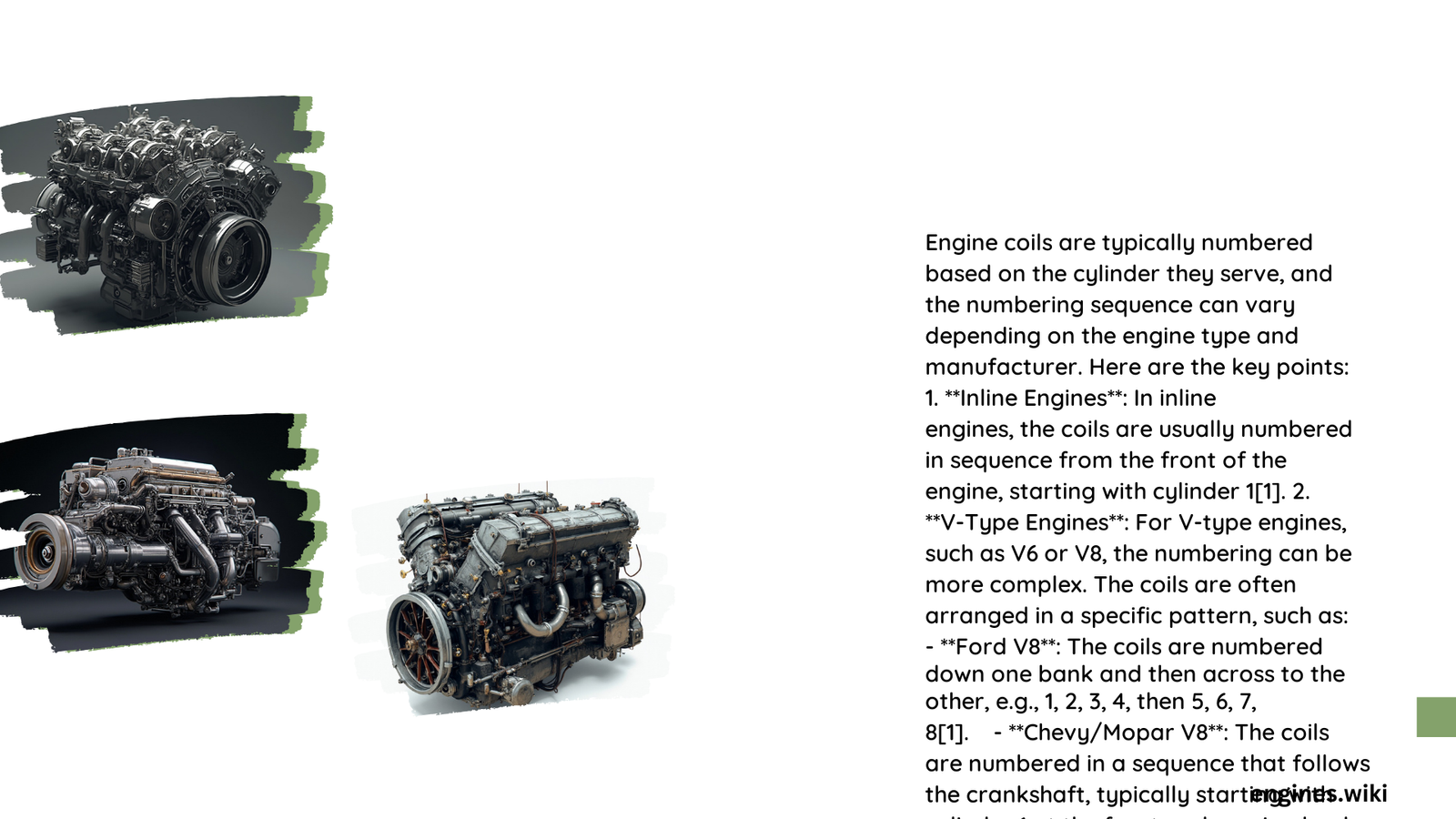Engine coils in modern vehicles are indeed numbered to facilitate identification and maintenance. This numbering system is closely tied to the cylinder numbering of the engine, which typically follows a front-to-rear pattern. For V engines, the numbering can vary between manufacturers. Each ignition coil corresponds to a specific cylinder, making it easier to troubleshoot and replace faulty components. Understanding this numbering system is crucial for proper engine maintenance and performance optimization.
What is the Engine Coil Numbering System in Modern Vehicles?
The engine coil numbering system in modern vehicles is designed to match the cylinder numbering of the engine. Here’s how it typically works:
- Cylinder Numbering:
- Most engines number cylinders from front to rear
- V engines may have different numbering systems depending on the manufacturer
- Example: Ford and Audi number cylinders sequentially on each bank (1-2-3-4 on left, 5-6-7-8 on right)
-
GM and Chrysler number based on crankshaft position
-
Coil Numbering:
- Each ignition coil corresponds to a specific cylinder
- In a V8 engine, coils are numbered 1 through 8
- This numbering helps identify which coil is associated with which cylinder
- Crucial for troubleshooting and replacement procedures
How Do Engine Coil Position Numbers Correlate with Wiring Diagrams?

The correlation between engine coil position numbers and wiring diagrams is essential for proper installation and maintenance. Here’s what you need to know:
- Inline Engines:
- Coils typically numbered from front to rear
-
Example: Straight-4 engine would have coils numbered 1-4
-
V Engines:
- Coils usually located on top of valve covers
- Each coil corresponds to a specific cylinder
-
Example: Chevy Small Block V8 firing order is 1-8-4-3-6-5-7-2, with coils numbered accordingly
-
Wiring Diagrams:
- Must match coil numbering for correct installation and troubleshooting
- Helps identify which coil to replace or inspect when check engine light appears
| Engine Type | Coil Numbering Pattern |
|---|---|
| Inline | Front to rear |
| V-type | Varies by manufacturer |
What are the Challenges in Engine Coil Identification?
Identifying engine coils can be challenging due to variations in numbering systems across manufacturers. Here are some key points to consider:
- Manufacturer-Specific Systems:
- Ford V8 engines use sequential numbering on each bank
-
GM V8 engines number cylinders based on crankshaft position
-
Potential Confusion:
- Different manufacturers may use different numbering schemes for similar engine types
-
Example: Dodge and Ford might have different numbering for V6 engines
-
Importance of Correct Identification:
- Crucial for proper replacement and maintenance
- Incorrect identification can lead to improper installation and engine performance issues
To overcome these challenges, always consult the vehicle’s specific manual or wiring diagram before working on engine coils.
What are the Key Measurements and Wiring Techniques for Engine Coils?
Understanding the measurements and wiring techniques for engine coils is crucial for optimal performance and reliability. Here are the essential aspects:
- Voltage Transformation:
- Ignition coils transform 12-volt battery output into high-voltage output
-
Can reach up to 45,000 volts for spark plug ignition
-
Wiring Diagrams:
- Accurate wiring ensures each coil receives correct signals from the ECU
-
Incorrect wiring can cause:
- Misfires
- Reduced engine performance
- Potential damage to the ignition system
-
Installation Considerations:
- Modern coils come in various shapes (e.g., pencil coils, plug-shaft coils)
- Often located on top of spark plugs
- Secure fastening and correct connection are vital for reliable operation
By understanding these measurements and techniques, you can ensure proper functioning of your engine’s ignition system and maintain optimal performance.
How Does Coil Numbering Affect Engine Performance?
The correct numbering and installation of engine coils directly impact engine performance in several ways:
- Proper Ignition Timing:
- Correct coil numbering ensures each cylinder fires at the right moment
-
Improves fuel efficiency and engine power output
-
Smooth Engine Operation:
- Properly numbered coils contribute to a smoother running engine
-
Reduces vibration and wear on engine components
-
Diagnostic Accuracy:
- Correct numbering allows for precise diagnosis of ignition-related issues
-
Enables quick identification and resolution of misfires or other problems
-
Maintenance Efficiency:
- Accurate numbering simplifies maintenance procedures
- Reduces time and cost associated with troubleshooting and repairs
By ensuring that engine coils are correctly numbered and installed, you can maintain optimal engine performance and longevity.
What are the Best Practices for Engine Coil Maintenance?
To keep your engine coils in top condition, follow these best practices:
- Regular Inspection:
- Check coils for signs of wear or damage
-
Look for cracks, corrosion, or loose connections
-
Proper Cleaning:
- Keep coils clean from oil and debris
-
Use appropriate cleaning solutions designed for electrical components
-
Timely Replacement:
- Replace coils at recommended intervals or when signs of failure appear
-
Always use OEM or high-quality aftermarket coils
-
Correct Installation:
- Follow manufacturer guidelines for installation
-
Ensure proper seating and connection of coils
-
Diagnostic Testing:
- Regularly test coil resistance and output
- Use a multimeter or specialized ignition system tester
By following these practices, you can extend the life of your engine coils and maintain optimal engine performance.
References:
1. Understanding Engine Firing Order for Your Vehicle | JEGS
2. WHERE IS IGNITION COIL 1 2 3 4 5 6 LOCATED ON A CAR
3. Firing order – Wikipedia
